#gudskul
Explore tagged Tumblr posts
Text
Pameran Komunitas Gubuak Kopi di Gudskul
0 notes
Text
Dari indonesia untuk italia, 2024
Dari indonesia untuk italia. Spontaneous Tips Vol. 1 a collaboration between Gudskul Ekosistem and Paola Pietronave March 2024, no ISBN edition: 50

View On WordPress
0 notes
Text
Learning from Friends: “The Collective School”
The below conversation was published in e-flux Education on March 30, 2023. Thank you, Tyler Considine, for the invitation.
Asia Art Archive (AAA) in Hong Kong recently hosted “The Collective School,” an exhibition and a program series exploring artist-driven and collective models of learning. Developed in collaboration with Gudskul, a Jakarta-based collective that runs a grassroots school for other collectives, the project provokes debates about the necessity and adaptability of collectives today. Amid the growing expectation for art institutions to address social change and learn from collaborative and self-organized initiatives, art collectives have become more relevant than ever. Here, Susanna Chung and Özge Ersoy, two members of the AAA team, discuss the exhibition’s unfolding and what they have learned in the process.
Özge Ersoy: Imagine: You walk out of the elevator onto the eleventh floor of an office building in one of Hong Kong’s old neighborhoods. Through the windows, you first encounter the city’s landscape. Focusing closer, you see a library, with tens of thousands of books nestled among artworks and archival documents about contemporary art collectives. You walk into a spacious reading room and see a large column with hand-drawn graphics highlighting some key values about the current exhibition. You read: knowledge sharing, learning from friends, and collective sustainability.
These concepts have been central to Asia Art Archive’s group discussions with the Jakarta-based Gudskul, our main collaborator for “The Collective School,” and eight other collectives: ba-bau AIR, Hanoi; BiSCA, Bishkek; Load na Dito and Salikhain Kolektib, Quezon City; Omnispace, Bandung; Pangrok Sulap, Sabah; Scutoid Coop, Kaohsiung; and Yayasan Tonjo Foundation, Yogyakarta. 1 Together, we asked: How can we shift the focus of art history from individual artists to communities? How do artists learn from each other outside of formal education and through collectives?
I’ve been excited about our collaboration with Gudskul, especially because they run a grassroots school for other collectives. For us, Gudskul’s model articulates a bold proposition about existing art-educational models: Art schools are often geared toward individual mastery, skill refinement, and career-oriented networking. In contrast, students at Gudskul are already members of existing collectives. They join other collectives to study historical precedents, discuss collective working models, and develop exhibitions and projects together. Eventually participants work as a collective of collectives.
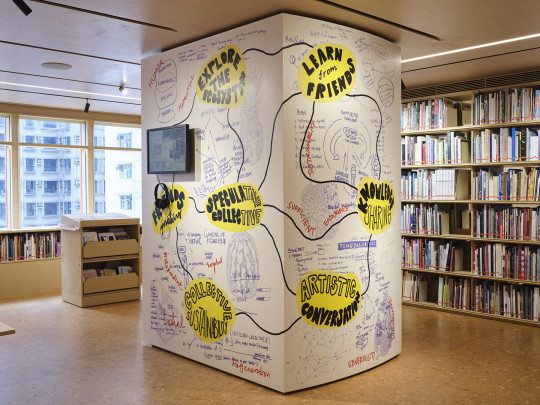
Gudskul, Temu Wall, 2022. Wall graphic with Gudskul, Veranda Talk, video. Installation view, “The Collective School,” CCG Library, Asia Art Archive, October 3, 2022–April 1, 2023. Photo: South Ho.
Susanna Chung: After we invited Gudskul to collaborate on “The Collective School,” they asked us to contribute to their study program. We joined Batch 4, the program’s fourth year, to develop it together with Gudskul and the cohort. While Batch 1 to Batch 3 were held at Gudskul’s campus, where collectives lived and studied together, Batch 4 was held completely online due to the pandemic. Collectives emerge in response to their unique contexts, and while many of them share ideas on the sustainability of collectives and the creation of education platforms, they respond to their contexts with different artistic practices. Becoming more adaptive and responsive to current events, Gudskul engendered new possibilities by connecting beyond Indonesia. As part of this unprecedented Batch, we were able to share and learn about different contexts in which collectivity persists.
Through four seminars, we introduced AAA’s extensive research on art pedagogies in relation to the development of contemporary art across Asia. After sharing case studies from China, India, the Philippines, and Thailand, we invited each collective to focus on one historical collective that most resonated. 2 Those who shared similar interests formed a group, which our researchers joined to exchange ideas, answer questions, and provide materials to inspire the collectives’ artworks. Our team crafted the exhibition narrative and display ideas only after all the works were finalized. All decisions were made in group discussions.
ÖE: The circular model of working diverges from our usual ways of organizing projects, which are often linear and entail a clear division of work. It’s refreshing. I would like to highlight an artwork here: In the middle of the library, we have a one-meter-high fire sculpture made by Quezon City–based collective Load na Dito. It is placed on top of a table covered with the reproduction of a black-and-white photograph depicting a burning action by Xiamen Dada, an art collective known for their radical performances critiquing art institutions in China in the late 1980s. This sculpture is further juxtaposed with a video documentary showing the creation of a four-meter-high effigy for a street demonstration by a group of collectives from Quezon City. Here, Load na Dito proposes the act of burning as a symbol of change and regeneration, a metaphor of collective actions that challenge institutions. By showing their connections with other collectives—both past and present—Load na Dito pays tribute to the legacy of activism of collectives and carries the torch forward.
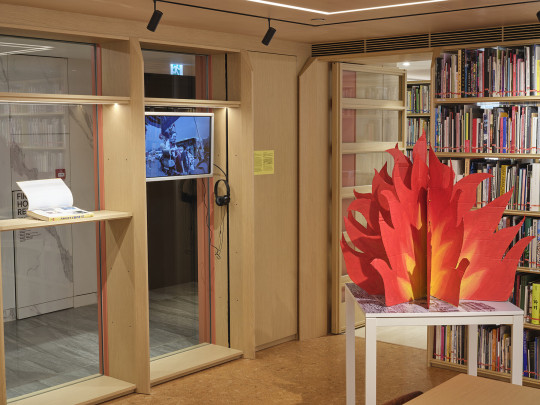
Load na Dito, Mad in Malacañang, 2022. Video, sculpture, and acrylic on cardboard. Installation view, “The Collective School,” CCG Library, Asia Art Archive, October 3, 2022–April 1, 2023. Photo: South Ho.
SC: Another compelling contribution is one between Pangrok Sulap and Salikhain Kolektib. They both responded to Womanifesto, a feminist art collective and biennial program in Thailand that was most active from the mid-1990s to the mid-2000s.
Pangrok Sulap uses woodcut print as their medium to empower rural communities. Depicting key moments in Womanifesto’s history, their work illustrates the solidarity among women artists and local craftspeople, prompting reflections about the role of artists as custodians of traditional cultural knowledge.
Salikhain Kolektib arranges archival materials about Womanifesto and their own collective chronologically. In the spirit of collaboration, Salikhain Kolektib joined Pangrok Sulap in creating a mirror display box. The mirroring effect melds the two collectives’ works in a fascinating way: the reverse of Pangrok Sulap’s print, featuring a protest for gender equality, can only be seen through Salikhain Kolektib’s artwork. Conversely, the partial reflections of materials through angled mirror slabs disrupt the chronological timeline of the latter’s installation. Rejecting the linearity and singularity of time and place, both collectives’ works invite us to think about sustainability, adaptability, and survival—common foundational concerns of contemporary art collectives.
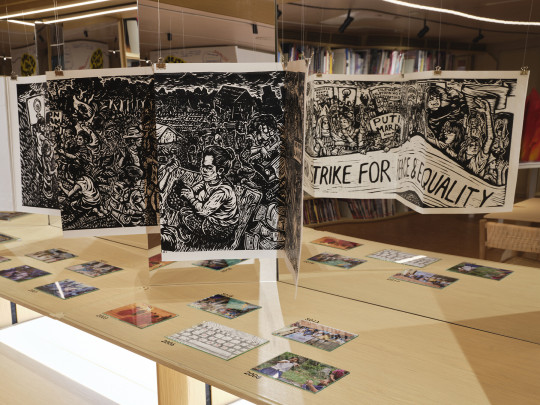
Salikhain Kolektib, Manifesting (In)constancy, 2022. Mixed-media installation; Pangrok Sulap, The Flower of the Nation, 2022. Woodblock print book. Installation view, “The Collective School,” CCG Library, Asia Art Archive, October 3, 2022–April 1, 2023. Photo: South Ho.
ÖE: It’s crucial that Gudskul, Batch 4, and our team discussed not only the potentials of working together but also the challenges and even limitations.
ba-bau AIR created an interactive jenga installation that materializes these conditions. Each hardwood block features terms from three texts related to Black Artists of Asia, a collective that initiated VIVA ExCon in the early 1990s. VIVA ExCon is the longest-running artist-led biennial in the Philippines, and this is another example of a contemporary collective revisiting art-historical documents and art actions in the region from the 1980s and 1990s.
As you begin building with the blocks, free associative readings about resilience and survival emerge. However, a jenga tower will eventually collapse, pointing to the tensions between construction and deconstruction. Yet when we think about the work not as a competition but as a cooperative game, the results become less finite. Your collective work might sometimes feel unstable, but the intention is to keep building together. Even if or when it collapses, other chances of regeneration will emerge.
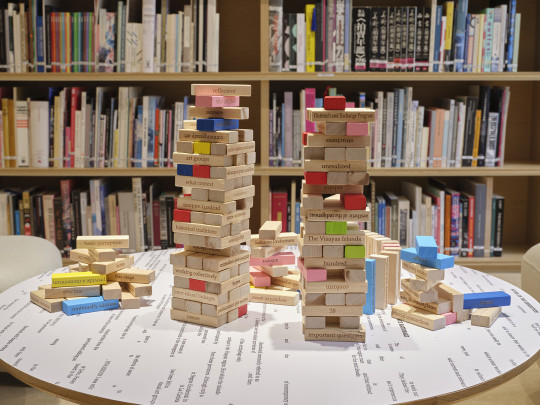
ba-bau AIR, Building a VIVA ExCon, 2022. Wood blocks. Installation view, “The Collective School,” CCG Library, Asia Art Archive, October 3, 2022–April 1, 2023. Photo: South Ho.
SC: The fluidity of art collectives, as showcased by “The Collective School,” inspires the work we do. An archive is a mobile being, constantly rethinking its positioning and priorities through connecting with artists and collectives.
Their ideas shape our research, programs, and the sites we inhabit. “The Collective School,” for instance, has made us reflect on our long-term interest in pedagogy as a site where modern and contemporary art histories of the region have been written. Beyond the role of art school, this project has also encouraged us to generate new questions about artist-led models of education and alternative pedagogies. Apart from learning in schools, artists also learn from their peers. Collectives can serve as a continuous learning platform for those who have completed art school, as well as those who have not attended art school.
ÖE: One important takeaway from this exploration of how art collectives learn and educate is their insistence on play. It has inspired new programs, such as “Assemblage at AAA,” a durational performance by Hong Kong–based collective Floating Projects. For two days in a row, members brought in found materials as well as items from our library and office and from their own space, and began creating.
I immediately think back to a conversation with Floating Projects, where member Wong Chun-hoi said, “We should be in the same space and play together, instead of talking about what we do and how we do it.”
In the performance, the space of the archive was activated by sharing and collective action. One artist assembled a chess-like game, another few built a sculpture with shredded paper of the collective’s confidential documents, while some others made music and did automatic writing. Anyone in the library was invited to join.
SC: This collective model of learning also helped me rethink our educator programs. Since 2013, we have been organizing the annual Teaching Labs, a professional development series for teachers, each year focusing on a theme that is relevant to contemporary art and education, with this year’s being art collectives.
Working with Gudskul taught me that “art collectives” is not simply a “theme” for study but a model of learning. It inspired me to experiment with a new program, “Knowledge Kitchen,” where ten artists and ten educators gather for six hours each month to engage with creative exercises, games, chats, dinners, and sharing sessions by guest artists. We would like to use this process to practice and experiment with new models of learning. Our goal is to explore how teachers and artists can co-learn, co-create, and co-work together.
Arts programming, like formal education, often transmits knowledge one way; artists or teachers unilaterally impart their knowledge and experience to an audience. This program seeks to cultivate a more open and equal environment for knowledge exchange. We want to link artists’ unique abilities to interpret the world with educators’ intimate understanding of classroom settings. It’s exciting to see what comes out of this. Who knows? Maybe self-organized collaborative projects, lifelong friendships, and more. Our hope is that through this exploration, teachers and artists will reconsider their relationships with students and audiences in various educational and artistic settings, and engage with new imaginations for the future.
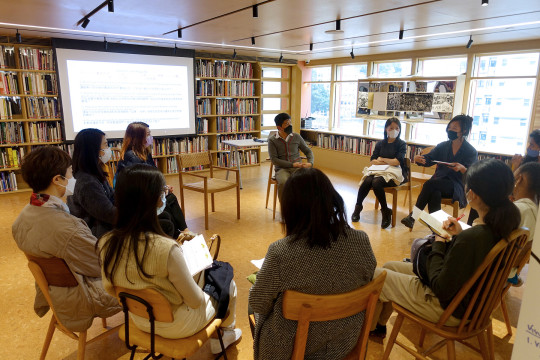
“Teaching Lab: Art between the Individual and the Collective,” Asia Art Archive, February 18, 2023. Courtesy of Asia Art Archive.
ÖE: Yes, we hope to move away from hierarchical ways of knowledge sharing. Apart from “Assemblage at AAA” and “Knowledge Kitchen,” we also hosted a live-streamed cooperative board game called “Speculative Collective.” Rather than inviting Gudskul and the eight collectives to present a talk, we asked them to show us what they cared about through playing. By responding to a series of challenge cards and drafting solutions, they revealed how they approach resource-sharing and collective decision-making. We wanted our audience to engage with—not to be told about—the exhibition.
SC: It’s important to us that this exhibition is the inaugural one of our newly renovated library. We have built a reading room in the center of the library, creating a space for co-working and co-learning, which also serves as a social space for discussion and learning from one another. Working with art collectives across Asia has not only helped us reorient the direction of our programming but has also allowed us to see the necessity and urgency of collectivity here in Hong Kong. We’ve deepened ties with our local partners Floating Projects and Rooftop Institute, whose practices revolve around alternative learning models. This is our first time studying the topic of collectives so closely, and the new library reflects who we are in the spatial sense. Since the beginning, we did not want the library to be a static collection, but rather a place to open up discussion. The study of collectives has made us realize that we share many values with Gudskul, such as learning from friends, engaging in artistic conversations, sharing knowledge, exploring the ecosystem, caring about sustainability, being speculative, and making friends, which are all essential for archive building.
A series of programs at the library resulted from organic discussions with these collectives. In particular, Hong Kong Conversations brought together different generations of artists and cultural workers to discuss historical and contemporary conditions that make collective work necessary in the city. The first talk gathered members from eight Hong Kong collectives founded in the 1990s—Southern Artists Salon, Green Wave Art, The Originals, Epical Chamber, NUX, Community Museum Project, Your Ears Covered, and Kultkuli—followed by three younger collectives—Black Window, Floating Projects, and Popo-Post Art Group. For me, it was a historical moment to see different generations of collectives in the same room, listening to and learning from each other.
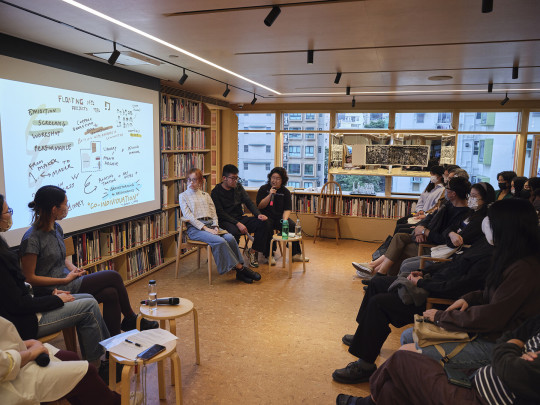
“Hong Kong Conversations 2022: The Collective School,” Asia Art Archive, November 26, 2022. Photo: South Ho.
ÖE: “The Collective School” is an example of how we see archives as social spaces to bring people together, to exchange knowledge, and to connect regional and local contexts. Some consider archives depositories that do not have to interpret or display their holdings. For us, artistic collaborations, including the ones developed from “The Collective School,” are crucial to challenge this view.
Our collaboration with Gudskul and eight other collectives taught me to insist on using exhibitions and programs as research as well as pedagogical tools. The project rearticulates our understanding of art history, one that prioritizes relationships and communities over individuals and singular artworks.
As part of “Assemblage at AAA,” here is an excerpt from the automatic writing of Linda Lai from Floating Projects: “A fresh new library surrounded by chaos and calm before a tempest. Free conversations absolutely free and automatic and without a frame from a handful of frames and many breakable frames.” 3 This is how I would like to imagine our library—a site for artistic intervention and knowledge via the engendering of fragments, play, and free associations, whether they are verbal, sculptural, or textual.
Notes
1. We are also grateful to our local Hong Kong partners Floating Projects and Rooftop Institute.
2. The case studies include the Stars Art Group, Xiamen Dada, and the New Measurement Group in China; Autonomous Women’s Movement in India; Black Artists of Asia in the Philippines; and Womanifesto in Thailand.
3 See →.
2 notes
·
View notes
Text

Seniman Aceh hidupkan bela diri Betawi di 'Jakarta Biennale 2024"
Seniman asal Aceh M Nur Fauzi berkolaborasi dengan Gudskul Ekosistem menghidupkan seni bela diri Betawi melalui karya gambar "Tapak Jejeg, "Jurus Keset Bacok" dan "Jurus Sikut Maen Pukul" yang dipamerkan di "Jakarta Biennale 2024".
Melalui karyanya ini, Fauzi menggambarkan jurus-jurus tradisional seni bela diri Betawi yang dikenal dengan istilah "maen pukul', sekaligus membuka dialog tentang cara seni dapat berperan dalam menjaga identitas budaya.
“Karya ini adalah cara saya untuk membantu melestarikan seni bela diri Betawi agar jurus-jurus seperti 'Tapak Jejeg' dan 'Jurus Keset Bacok' tidak hilang ditelan perkembangan zaman," kata Fauzi dalam keterangannya di Jakarta, Selasa.
Berita lengkapnya : Klik disini
0 notes
Text
Penetrating the limits of creativity: Denny Ja revives the work of Andy Warhol
Denny Ja, a famous visual artist in Indonesia, again stole the attention of the art world with his latest project who succeeded in reviving Andy Warhol's iconic works. This project is a concrete example of how innovation and creativity can bring change to the world of art. Andy Warhol, is an American artist who is famous for his work focused on pop art and consumer culture. Warhol is considered one of the most influential artists in the 20th century. His works, such as the paintings of Marilyn Monroe and Campbell Soup Cans, have become popular cultural icons and have great appeal. However, Denny JA has a different view of Warhol's work. For him, Warhol's works are a challenge, an idea that can be reprocessed and re-interpreted. When Warhol was still alive, he often criticized the art industry which he looked at as an industry that stopped developing and innovating. In order to revive these ideas, Denny JA launched a new project entitled "21st Century Warhol". This project presents Warhol's works that have been re-processed using the latest technology, such as 3D animation and Augmented Reality. In this project, Warhol is the starting point of an infinite exploration of creativity. One of Warhol's re -processed works in this project is Marilyn Monroe. In his famous work, Warhol depicts Monroe in striking colors, such as red and yellow. However, in the Denny JA version, Marilyn comes in a very realistic 3D animation form. Through augmented reality technology, visitors can see Monroe hovering before their eyes, hidden behind digital layers. According to Denny Ja, this project also has a symbolic meaning. Warhol's re-processed works represent courage in experimenting and exploring unknown arts. This project also shows that art does not have to be neutral or rigid, but art must continue to innovate and be involved in creative conversion with the natural surroundings. However, the "21st Century Warhol" project is not controversial without reason. As a highly respected artist, Warhol has a large and loyal fan base throughout the world. Some fans and art collectors feel that Warhol's re-processing is an act of disrespect to the maestro. Denny Ja realized the criticism, but he remained convinced that this project was not an intellectual insult or theft. For him, Warhol is an innovator who introduces new ideas into the world of art. The "21st Century Warhol" project is only a continuation of Warhol's courage and creativity in experimenting and building a legacy that is not eroded by time. Denny Ja has long been one of the most famous visual artists in Indonesia. He is the founder of Gudskul, an arts and education community that has a mission to build a new network that is wide open for learning and sharing knowledge among artists and art practitioners. Through Gudskul and other creative projects, Denny Ja has brought significant changes to the Indonesian art world. The "21st Century Warhol" project not only brings Warhol's ideas into the modern era, but also shows that innovation and creativity can change the world of art. When artists start collaborating with new technology and media, the opportunity to create extraordinary works is getting bigger. This project teaches us that art does not have to be a static or neutral entity, art is a combination of innovation, creativity and conversion with its environment. Denny Ja has penetrated the limits of creativity by reviving Warhol's works, and inviting us to continue to innovate and experiment in creating works that will open new horizons for the art world.
Check more: Breaking the limits of creativity: Denny JA revives the work of Andy Warhol
0 notes
Photo
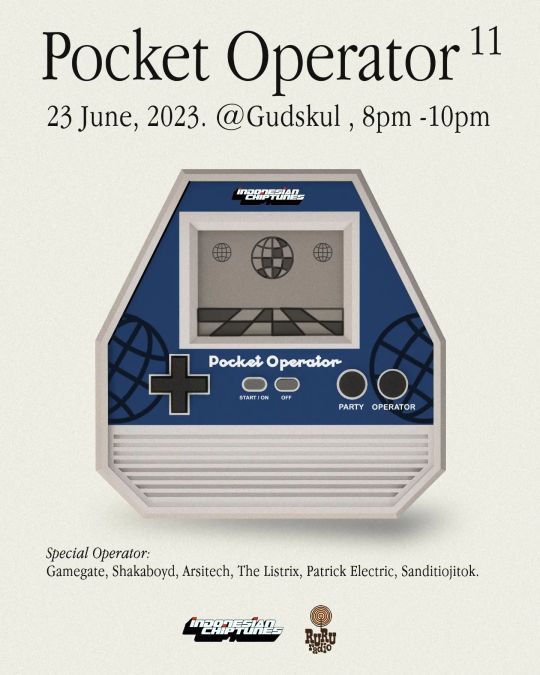
🇮🇩 From @8beatslab: We are back! Another episode of Pocket Operator will begin this week. FRIDAY, JUNE 23 Start from 8PM WIB At Gudskul Ekosistem Special Operators by: GAMEGATE @gamegate_chipmusic SHAKABOYD @shakaboyd ARSITECH @mr_procks THE LISTRIX @rezki_ SANDITIOJITOK @sanditio_jitok PATRICK ELECTRIC @alfian_nay93 Supported by: @rururadio @gudskul #chiptune #chiptunes #chipmusic #indochiptunes #pocketoperator #chiptuneshow #rururadio #gudskulekosistem https://instagr.am/p/CtwiXMYtdO7/
0 notes
Photo
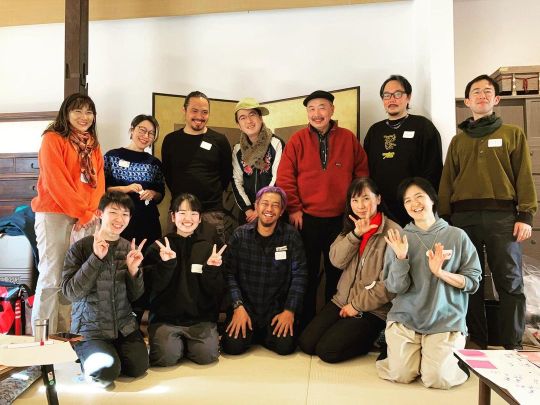
Thank you for joining our joint workshop by @eemjiee @gudskul by courtesy of @sumida_expo @bunkan_life @ggdd5308 & all of the local participants❣️ It was a warm,fun time thinking & working together! Let's keep going✨ 詳細: event details https://gudskulws.peatix.com/ FB: https://fb.me/e/2EMrVRxf5 ・ ・ ・ #coiki #artslivingspace #contemporaryartist #creatives #creativeliving #cocreating #cocreative #cocreativecollective #creativeplatform #creativecommunity #artistinresidence #artistresidency #artistresidencyprogram #artistinresidencejapan #cocreativesession #artisttalk #locality #contemporaryart #creativeresearch #curators #polytopia #gudskul #documentafifteen #lumbung #indonesiancollective #indonesianartists #workshop #collective #livingtogetherco https://www.instagram.com/p/CpNJ9pWSQag/?igshid=NGJjMDIxMWI=
#coiki#artslivingspace#contemporaryartist#creatives#creativeliving#cocreating#cocreative#cocreativecollective#creativeplatform#creativecommunity#artistinresidence#artistresidency#artistresidencyprogram#artistinresidencejapan#cocreativesession#artisttalk#locality#contemporaryart#creativeresearch#curators#polytopia#gudskul#documentafifteen#lumbung#indonesiancollective#indonesianartists#workshop#collective#livingtogetherco
0 notes
Photo


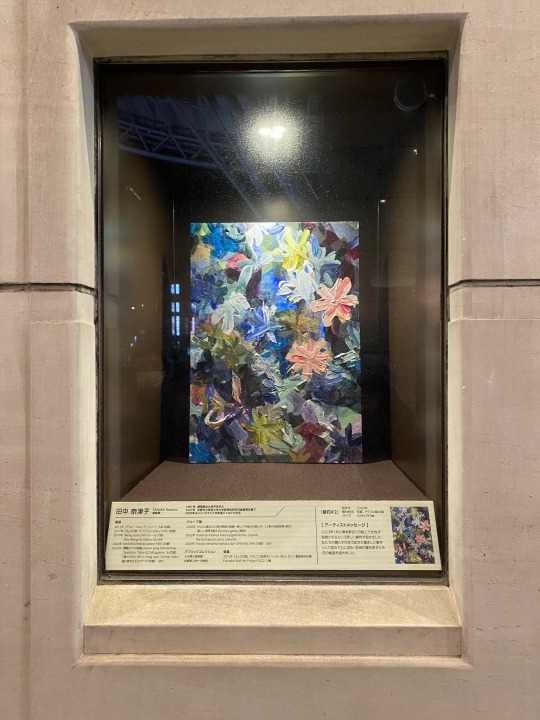

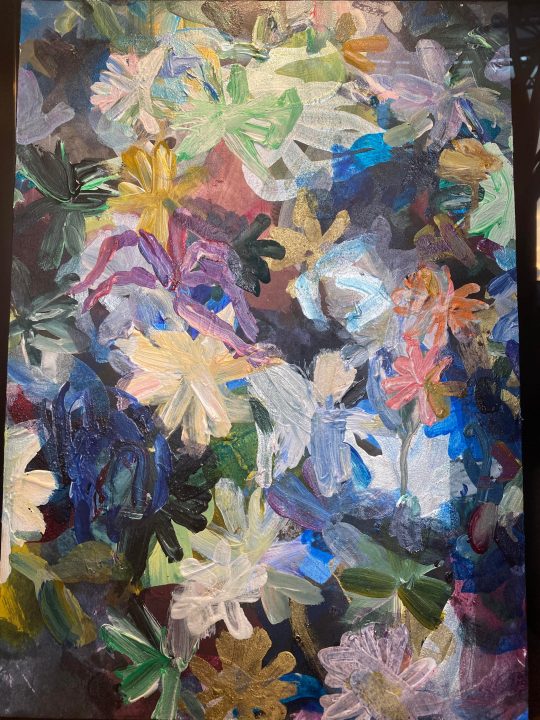
●博多阪急アートキューブ 2023/02/08〜3/28 田中奈津子●
実はこの企画にお誘いいただき、artbase88の宮本さんと博多阪急の入口で打ち合わせしていた日、ほぼ時を同じくして、すぐ近くの路上で女性が殺害されるという事件が起こりました。 翌日のニュースを見て唖然としました、場所が近かったこと、被害者の川野さんと年齢が近かったことなど、自分の身体の上にも痛みが走りました。 なぜこのような事件が起きてしまうのでしょう? 個人間の問題と片付けてしまえるでしょうか。。。 日本社会にはいま、他者の問題にできるだけ関わらない、不寛容さが悲しくも奥底に響きわたっているように思います。 いっぽうで事件現場にたくさんの花や手紙などが捧げられていました、 見知らぬ人が自分の家族と重ね合わせて手を合わせている姿も テレビで見ました。やはり日本人のどこかにまだ、共感する心があるようにも思います。 複雑な現代社会に絵画ができることは、本当にちいさなことかもしれません。 それでも枯れない花を捧げることは出来ます。 ------------------------------------------------------------------------------------------ 博多阪急アートキューブ 2023/02/08〜3/28 田中奈津子 作品 公式サイト https://website.hankyu-dept.co.jp/.../h/artcube/index.html 期間 2月8日(水)~3月28日(火) 作家名 田中 奈津子(Tanaka Natsuko) 作品名 左)『献花#1』 右)『献花#2』 素材技法 和紙、アクリル絵の具 サイズ 420×297mm 制作年 2023年 ●アーティストメッセージ 2023年1月に博多駅近くの路上で女性が殺害されるという悲しい事件が起きました。私たちの暮らす社会で起きた痛ましい事件として省みて心に刻み、哀悼の意を表すため花の絵画を描きました。 田中 奈津子(Tanaka Natsuko)/ 美術家 1981年 福岡県北九州市生まれ 2007年 京都市立芸術大学大学院美術研究科絵画専攻修了 2020年よりインドネシア共和国ジャカルタ在住 ●主な個展 2011年 『デコレーション』アートスペース虹(京都) 2017年 『きょうの壺 プレミアム』Gallery PARC(京都) 2019年 『Being series』ギャラリー白(大阪) 『into Being』d3 Gallery(北九州) 2020年 『ANDROGYNOS』Gallery PARC(京都) 2022年 『隔離された絵画-Lukisan yang Dikarantina』Operation Table(北九州), galerie 16(京都) 『遠くからはっきりと-Yang Jauh Terlihat Jelas』堀川新文化ビルヂング(京都) ほか ●主なグループ展 2020年 『VOCA展2020 現代美術の展望─新しい平面の作家たち─』上野の森美術館(東京) 『新しい境界を超える』konya gallery(福岡) 2022年 『Katanya Katanya Katanya』galerikertas (Depok) 『Re:Gyotaku』Gudskul (Jakarta) 2023年 『Asobo bersama Natsuko dan GHH』NEUTRAL(京都) ほか ●パブリックコレクション 大分県立美術館 京都第二赤十字病院 ●主な受賞 2015年 『きょうの壺』 マネックス証券Art in the office 2015 審査員特別賞 Fukuoka Wall Art Project 2022 入賞 キュレーター 川浪千鶴、原田真紀 ディレクション ART BASE 88(宮本初音)
0 notes
Photo







Gudksul Ekosystem Exhibition is held for short courses held every year. info https://gudskul.art/short-course/. A short illustration course mentored by @drawmama.
Art Installation by Xasemele - 2019 At Gudside
1 note
·
View note
Text
Simpang Susun Arsip dari Alam Ingatan
0 notes
Photo
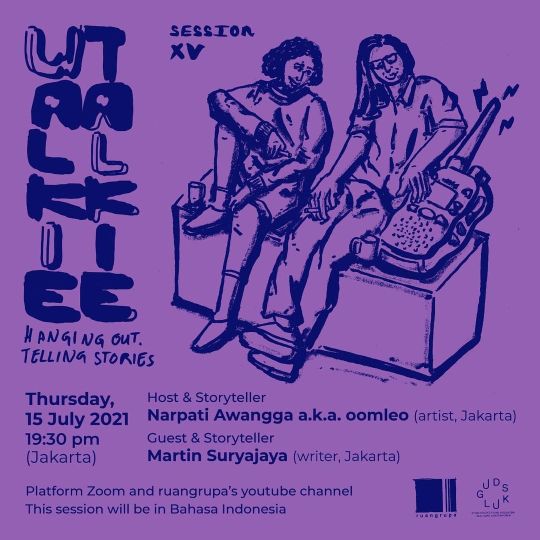
WALKIE TALKIE Hanging Out, Telling Stories Sesi XV Pemandu & Pencerita: Narpati Awangga a.k.a. oomleo (seniman, Jakarta) Tamu & Pencerita: Martin Suryajaya @martinsuryajaya (penulis, Jakarta) Kamis, 15 Juli 2021 19:30 WIB (Jakarta) Platform zoom dan youtube live ruangrupa @ruangtupa Sesi ini akan berlangsung dalam Bahasa Indonesia WALKIE TALKIE: Sesi nongkrong daring sambil bercerita tentang arti bekerja sama dan hidup berdampingan. Program berkala ini digelar oleh ruangrupa bersama teman-teman dari berbagai latar belakang geografis dan profesi. ---------------------------------------------------------- WALKIE TALKIE Hanging Out, Telling Stories Session XV Host & Storyteller: Narpati Awangga a.k.a. oomleo (artist, Jakarta) Guest & Storyteller: Martin Suryajaya (writer, Jakarta) Thursday, 15 July 2021 19:30 pm (Jakarta) Platform: zoom and ruangrupa’s youtube channel This session will be in Bahasa Indonesia WALKIE TALKIE: a hanging out telling stories conducted by ruangrupa to connect with some friends where proximity doesn’t refer to something geographical or physical. It’s about stories on what it means to work and to live together. #walkietalkie #hangingout #tellingstories #ruangrupa #gudskul https://www.instagram.com/p/CRTRkAIgyC2/?utm_medium=tumblr
0 notes
Photo

QUO VADIS KONSUMER SASTRA? – TITIKDUA EDISI 11022021 _ Jika tak ada konsumen, apakah masih ada karya sastra? Jika tak ada pembeli? Apakah masih ada produsen? Ini semacam tarik ulur tawar menawar, mekanisme pasar yang kata ERK sih, Pasar Bisa Diciptakan. Apakah sastra bisa menciptakan pasar sendiri? _ titikdua segalanya tentang sastra kadang beli, kadang pinjam, kadang nyolong, kadang minta buku-buku karya sastra buat dibaca. Tidak semua buku karya sastra Indonesia yang kami punya beres kami baca, wahay Skoyers sekalian. Gimana ya? Ya gitu deh…. Malam ini, kita akan berbincang dengan Jual Buku Sastra (@jualbukusastra) perihal sejauh apa animo manusia Indonesia membeli buku sastra. Dengar-denger sih, Skoyers, katanya selama #WHF, orang Indonesia jadi rajin beli buku sastra. Tau deh, benar apa engga. Tau deh benar apa engga. _ Para pembeli buku, para penjelajah toko buku online, para penjelajah toko buku online lalu nanya stok buku lalu bilang mau beli tapi lupa transfer, hanya malam ini pukul 21.00 WIB, streaming tanpa delay di rururadio.org! _ #pembeli #pembelibuku #pembelibukusastra #jualbuku #jualbukusastra #titikdua #rururadio #ruangrupa #gudskul #gudskulekosistem (di Kedai JBS) https://www.instagram.com/p/CLJLU6EH0kP/?igshid=1fqc39uhr1wk6
#whf#pembeli#pembelibuku#pembelibukusastra#jualbuku#jualbukusastra#titikdua#rururadio#ruangrupa#gudskul#gudskulekosistem
0 notes
Photo

Ruang gabungan @projekrabak @kolekipoh @cormisme dan @pbuy ; @kedutaanipoh bakal menyaksikan satu lagi pameran Malaysiana dari sisi counter culture. Pameran selama seminggu lebih ini bakal membawakan Amin Morris juga menampilkan Mohd Jayzuan selaku kurator. PROJEK RABAK, KEDUTAAN IPOH & GUDSKUL mempersembahkan ‘Rock Kapak Never Dies’ Pameran Installation Art: Sebuah kerja-seni homage kepada muzik rock Malaysia 21 Disember - 1 Januari 2020 Seniman: Amin Morris Kurator: Mohd Jayzuan Kedutaan Ipoh Gudskul Ekosistem Jl. Durian Raya No. 3A Jagakarsa Jakarta Selatan #projekrabak #kedutaanipoh #gudskul #jakarta #indonesia (at Marjin Kiri) https://www.instagram.com/p/B6Fuc2kB0u-/?igshid=151s4ole9u657
0 notes
Photo

#새로운지식을 위한 배움의도구와미술관#루앙루파#serum#collectiveisschool #gudskul #rurugako#mgpringgotono #anggawijaya 루앙루파에서 시작된 교육 콜렉티브 굿 스쿨의 발제 "콜렉티브가 헉교다."가 진행 중이다. (서울시립 북서울미술관에서) https://www.instagram.com/p/B6CkZa2JihR/?igshid=t30m0oggr818
0 notes
Photo

MARKING PLACES #1 CONJUNCTION Personal project by Christopher Danang Berangkat dari ketertarikan pada wacana seputar interaks manusiai yang dipadukan dengan proses pemetaan di lingkungan sekitar. Projek ini mencoba menghadirkan bagaimana pertemuan 2 variabel yang berbeda, secara tidak langsung menghadirkan premis-premis baru di dalam kehidupan sosial masyarakat urban khususnya DKI Jakarta. Pameran : 24-28 Agustus 2019 Medium: Ilustrasi, grafis, aksi performative, benda Rumput beton Pencil on stained paper (59x34)cm Nodus tolens Pencil in stained paper (59x42)cm Suplantas Pencil on stained paper (19.5x26,5)cm Bar Jamu Pencil on stained paper (29.7x42)cm Fotkop | Third Eye Space Jl. Nangka I No.6, RT.2/RW.5, Cipete Utara, Kec. Kby. Baru, Jakarta Selatan, 12410 @gudskul @fotkop_ @thirdeyespace . #exhibition #personalproject #artlab #gudskul #kelasbantam #studikolektif #ekosistem #fotkop #thirdeyespace https://www.instagram.com/p/B1ntyadAOO-/?igshid=q3m68s4iv03q
#1#exhibition#personalproject#artlab#gudskul#kelasbantam#studikolektif#ekosistem#fotkop#thirdeyespace
0 notes